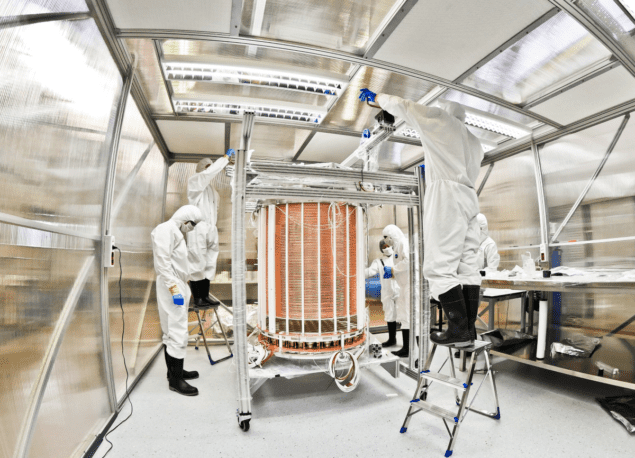
An exotic and extremely rare nuclear decay that involves the simultaneous capture of two atomic electrons by a xenon-124 nucleus has been observed in a dark-matter detector. Physicists in the XENON Collaboration have measured the half-life of the two-neutrino double electron capture process to be about 1022 years, which is about one trillion times the age of the universe. Studying this rare decay could shed light on a related process called neutrinoless double electron capture, which if observed, would reveal important information about the nature of the neutrino that goes beyond Standard Model of particle physics.
Electron capture is a common mode of nuclear decay that occurs when an atomic electron interacts with a proton in the nucleus to create a neutron and an electron neutrino. Two-neutrino double electron capture occurs when two electrons are captured at once and is a much rarer process. As well as providing important information about the structure of the nucleus, observing two-neutrino double electron capture could help physicists devise experiments to observe neutrinoless double electron capture. This hypothetical process can only occur if the neutrino is its own antiparticle, which is not predicted by the Standard Model. As well as establishing the neutrino as the first elementary particle to be a Majorana fermion, detecting neutrinoless double electron capture would provide important information about the absolute mass of the neutrino.
Buried deep under Gran Sasso mountain in Italy, the XENON1T dark matter detector contains about 3 tonne of ultrapure liquid xenon. The experiment ran for one year in 2017-18 looking for hypothetical dark-matter particles called WIMPS, which are expected to collide occasionally with xenon nuclei. Collisions would produce light and electrons, which can both be detected by the apparatus.
Auger electrons
While XENON1T has seen no evidence for WIMPS, physicists were also on the look-out for X-rays and Auger electrons emitted from tellurium-124 atoms – which are produced when xenon-124 undergoes two-neutrino double electron capture. The XENON team spotted 126 such events in the detector over the course of a year. Although xenon-124 makes up only about 0.1% of the xenon in the detector, there is still a huge number of the nuclei present. Knowing the number of xenon-124 nuclei in the detector and the number that decayed in a year allowed the team to calculate the half-life of two-neutrino double electron capture to be 1.8×1022 years, which is the longest half-life ever measured directly.
XENON1T is now being upgraded to create XENONnT, which will comprise 8 tonne of xenon and have even lower background radiation levels. The XENON team say that their discovery “sets the stage” for searches for neutrinoless double electron capture and other exotic decay processes using XENONnT as well as two other upcoming detectors – LZ to be built in the US and PandaX-4T in China.
The research is described in Nature.



